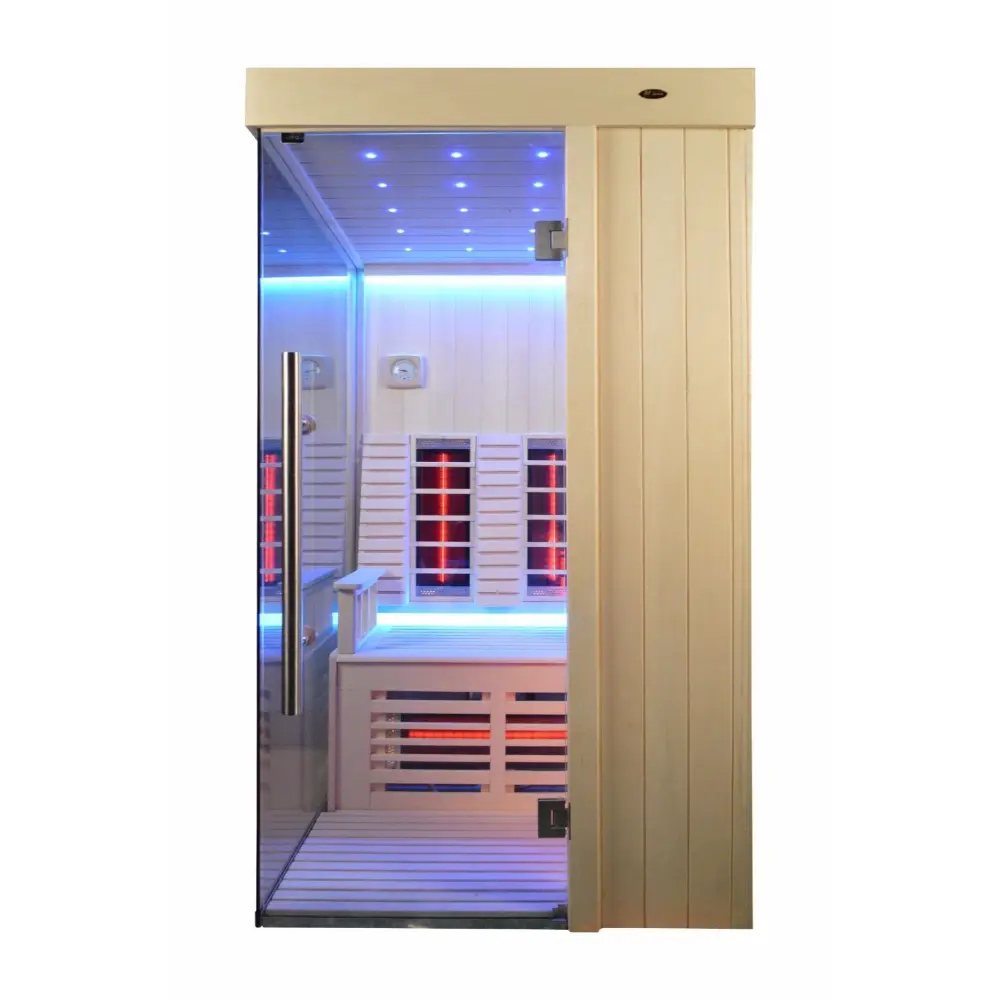If you’re considering purchasing a 2-person infrared sauna for your home, you’re likely wondering, “How much does it cost to run an infrared sauna?” This article will break down the costs associated with running a 2-person infrared sauna, including electricity consumption, energy efficiency, and long-term savings. By the end of this guide, you’ll have a clear understanding of what to expect when it comes to operating costs and how to make the most of your sauna experience.
What Is an Infrared Sauna and How Does It Work?
Infrared saunas use radiant heat to warm your body directly, rather than heating the air around you like traditional saunas. This efficient heating method allows for lower energy use and a more comfortable experience. Unlike traditional steam saunas, infrared saunas don’t rely on high humidity levels, making them a popular choice for home installations.
Why choose an infrared sauna?
- Infrared saunas heat up faster and use less electricity than traditional saunas.
- They provide numerous health benefits, such as improved circulation, detoxification, and relaxation.
How Much Power Does a 2-Person Infrared Sauna Use?
The average 2-person infrared sauna is equipped with heaters that operate between 1.5 kW and 2 kW per hour. This translates to 1.5–2 kilowatt-hours (kWh) of electricity consumption during a typical sauna session, which lasts around 30–60 minutes.
Quick Power Facts:
- Power Rating: 1.5–2 kW
- Session Duration: 30–60 minutes
- Electricity Consumption per Hour: 1.5–2 kWh
Electricity Consumption of Infrared Saunas vs. Traditional Saunas
Infrared saunas are known for their energy efficiency. Traditional steam saunas require higher temperatures (often exceeding 180°F) to deliver the same level of relaxation, resulting in significantly higher electricity consumption.
| Feature | Infrared Sauna | Traditional Sauna |
| Operating Temperature | 120–140°F | 160–200°F |
| Electricity Consumption | 1.5–2 kWh | 6–8 kWh |
| Warm-Up Time | 10–15 minutes | 30–45 minutes |
Key takeaway: Infrared saunas consume significantly less power than traditional saunas, making them a cost-effective choice for regular use.
The Cost of Electricity: What You Need to Know
The cost of running your infrared sauna depends on your local electricity rate. In the United States, the average electricity rate is approximately $0.12 per kWh. Let’s calculate the cost of a 60-minute session in a 2-person infrared sauna:
- Electricity Rate: $0.12 per kWh
- Power Consumption: 2 kWh
- Cost per Hour: 2 × $0.12 = $0.24
At just $0.24 per hour, running an infrared sauna is an affordable luxury.

Energy Efficiency of Infrared Saunas
One of the main reasons infrared saunas are so popular is their exceptional energy efficiency. The heaters in these saunas are designed to target your body directly, minimizing wasted energy.
Energy-Saving Features of Infrared Saunas:
- Faster heat-up times reduce overall electricity use.
- Lower operating temperatures require less energy.
- Advanced insulation keeps heat contained, further improving efficiency.
Factors That Affect the Cost of Running an Infrared Sauna
Several factors can influence how much it costs to run your infrared sauna:
- Electricity Rates: The price of electricity varies by location.
- Frequency of Use: More frequent use will naturally increase costs.
- Session Duration: Longer sessions consume more electricity.
- Insulation Quality: Better-insulated saunas retain heat more effectively.
How to Calculate the Cost of Running Your Infrared Sauna
To calculate the cost of running your sauna, follow this simple formula:
Cost = Power Consumption (kW) × Electricity Rate (per kWh) × Usage Time (hours)
For example:
- Power Consumption: 2 kW
- Electricity Rate: $0.12 per kWh
- Usage Time: 1 hour
- Cost: 2 × $0.12 × 1 = $0.24
Comparing Infrared Saunas to Traditional Steam Saunas
While both infrared and traditional saunas offer unique benefits, infrared saunas are more cost-effective and energy-efficient. Here’s how they compare:
| Aspect | Infrared Sauna | Traditional Sauna |
| Initial Cost | 1,500–1,500–5,000 | 3,000–3,000–10,000 |
| Energy Efficiency | High | Moderate |
| Operating Cost | 0.12–0.12–0.24 per session | 1–1–2 per session |
| Maintenance Requirements | Low | Moderate |
Pro Tip: If you’re looking for a sauna that’s both budget-friendly and environmentally friendly, an infrared sauna is the way to go.

Tips to Reduce the Cost of Running Your Infrared Sauna
Here are some practical tips to minimize your sauna’s operating costs:
- Use a timer: Avoid leaving your sauna on for longer than necessary.
- Opt for energy-efficient models: Look for saunas with advanced heater technology.
- Keep the door closed: Ensure the sauna door is properly sealed to prevent heat loss.
- Install in a well-insulated space: This reduces the need for additional heating.
Frequently Asked Questions About Infrared Sauna Usage
1. How much electricity does an infrared sauna use per month?
If you use your sauna for 30 minutes a day, 5 times a week, the monthly electricity consumption would be approximately 20 kWh. At an average rate of $0.12 per kWh, this totals $2.40 per month.
2. Are infrared saunas expensive to maintain?
No, infrared saunas are low-maintenance. They don’t require water or plumbing, and the main upkeep involves cleaning and occasional heater checks.
3. Can I run my infrared sauna on solar power?
Yes, infrared saunas are compatible with solar power systems. Their low energy requirements make them ideal for sustainable energy solutions.
Internal Links for More Information
Explore these helpful resources for more insights on infrared saunas:
- Far Infrared Sauna Room China-IFL-2102A
- Far Infrared Sauna Dealer-IF-2105
- Far Infrared Sauna Room Wholesaler-IFL-2103A

Key Takeaways
- A 2-person infrared sauna typically costs 0.12–0.12–0.24 per session to run.
- Infrared saunas are more energy-efficient than traditional steam saunas.
- Factors like electricity rates and insulation quality can affect operating costs.
- With proper maintenance and energy-saving practices, you can keep costs low.
By understanding the costs involved, you can enjoy the benefits of an infrared sauna without breaking the bank.
